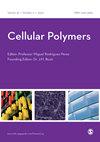超临界CO2浸渍法制备控制百里酚释放的附加值多孔材料
IF 1.9
4区 医学
Q4 MATERIALS SCIENCE, BIOMATERIALS
引用次数: 6
摘要
本研究探索了利用可生物降解和生物相容性聚合物控制天然生物活性物质的释放。为此,采用环保的超临界二氧化碳(scCO2)浸渍工艺,用百里香酚浸渍聚ε-己内酯(PCL)珠、乙酸纤维素(CA)膜和聚乳酸-乙醇酸(PLGA)薄片。在选定的压力和温度下,操作时间的延长增加了百里酚的负荷。纯scCO2不会影响平均孔径约为3µm的CA膜,但它使PCL珠粒和PLGA薄片能够分别变为平均孔径约175µm和87µm的泡沫。除了scCO2,百里酚还起到增塑剂的作用,使聚合物的孔径增加了三倍。使用磷酸盐缓冲盐水在37°C下测试选定样品中百里酚的释放动力学,并用Korsmeyer–Peppas、零阶、一阶和Higuchi模型成功描述。PCL、CA和PLGA超临界浸渍的建议方法导致了多孔、无溶剂、附加值材料的开发,这些材料可以在5小时到几天内以可控的方式释放百里酚。本文章由计算机程序翻译,如有差异,请以英文原文为准。
Added-value porous materials for controlled thymol release obtained by supercritical CO2 impregnation process
This study explores utilization of biodegradable and biocompatible polymers for controlled release of natural bioactive substance. For that purpose, poly(ε-caprolactone) (PCL) beads, cellulose acetate (CA) film, and poly lactic-co-glycolic acid (PLGA) flakes were impregnated with thymol by employing environmentally friendly process of supercritical carbon dioxide (scCO2) impregnation. At selected pressure and temperature, prolongation of operating time increased thymol loading. Pure scCO2 did not affect CA film with average pore diameter of approximately 3 µm, while it enabled change of PCL beads and PLGA flakes into foams with average pore diameter approximately 175 µm and 87 µm, respectively. Additionally to scCO2, thymol acted as a plasticizer increasing pore size of polymers up to three times. Kinetic of thymol release from selected samples was tested using phosphate buffer saline at 37°C and successfully described with Korsmeyer–Peppas, zero-order, first-order, and Higuchi models. The suggested method of PCL, CA, and PLGA supercritical impregnation led to development of porous, solvent free, added-value materials that release thymol in a controlled manner from 5 h to several days.
求助全文
通过发布文献求助,成功后即可免费获取论文全文。
去求助
来源期刊

Cellular Polymers
工程技术-材料科学:生物材料
CiteScore
3.10
自引率
0.00%
发文量
9
审稿时长
3 months
期刊介绍:
Cellular Polymers is concerned primarily with the science of foamed materials, the technology and state of the art for processing and fabricating, the engineering techniques and principles of the machines used to produce them economically, and their applications in varied and wide ranging uses where they are making an increasingly valuable contribution.
Potential problems for the industry are also covered, including fire performance of materials, CFC-replacement technology, recycling and environmental legislation. Reviews of technical and commercial advances in the manufacturing and application technologies are also included.
Cellular Polymers covers these and other related topics and also pays particular attention to the ways in which the science and technology of cellular polymers is being developed throughout the world.
 求助内容:
求助内容: 应助结果提醒方式:
应助结果提醒方式:


